
Skagway, Alaska
Skagway |
|
Skagway roared to life in 1897 after newspapers in Seattle reported with monster headlines that a ship had arrived from Alaska loaded with tons of GOLD. The gold rush was on. Within months Skagway became the staging (and rest0 station for eager goldseekers, known as stampeders. Here the ships arrived from Seattle and from here the stampeders had to begin the ardous hike to the actual goldfields in the Yukon territory, 550 miles away. The Canadian authorities required each stampeder to bring one year's supply of food and other necessities, about 2,000 pounds. Stampeders either used packmules, old horses or had to make many trips up and down the Chilkoot or White pass backpacking the supplies. The population of Skagway ballooned to about 10,000 people. Stampeders, crooks, tavern owners, shokeepers, 30 attorneys, and, of course, ladies of the night. Skagway became a town without law or morality.

The actual goldrush only lasted about one, two years and very few actually found gold, and most of them spent it either in Skagway or in Seattle where about 2,000 "seamstresses" relieved the stampeders of their treasures.
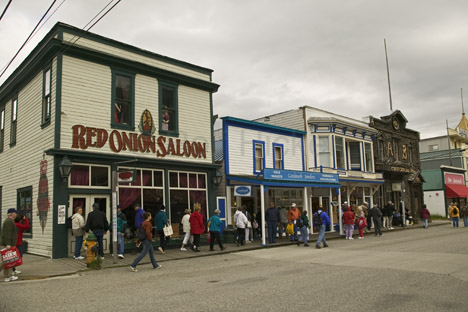
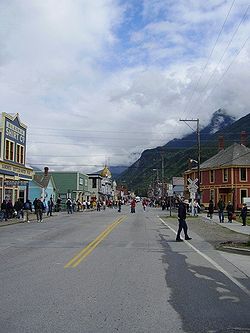
Today Skagway is a National Historical District (or park) which includes the Goldrush museum in Seattle. The remaining historical buildings are owned by the national Park and are leased to business which do their best to relieve the cruiseship tourists of their cash. The population is about 900 yearround, double that in the summer for tourist season.
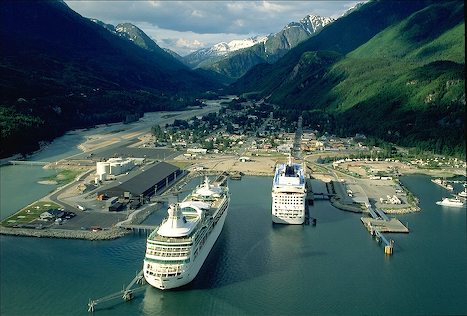
Tourists like us. After our disappointment in Juneau where fog ruined our plans to helicopter to teh mendenhall glacier, wie were looking forward to our helicopter trip to the Denver glacier. Below we are waiting for our chopper, already attired in life jackets and snow boots. Also, Nick in the chopper.

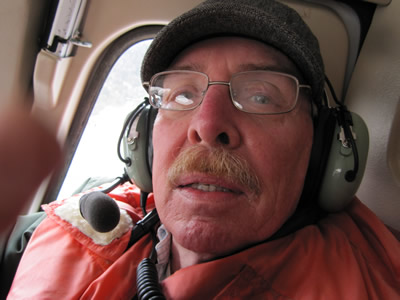
The flight was very interesting - I had never been in helicopter and realistically, my next best opportunity is likely to involve a stretcher and I will NOT enjoy it! So, this was a lot more fun! Below views from the helicopter



Our destination was the Denver glacier (it was snowing, it essentially was still winter and so it was a lot of snow and ice.) Much more interesting was what is ON the glacier: 240 sled dogs. The pictures below show the camp from teh air and tehn some of the dogs, each with its own house, etc. This is a kennel where dogs train for actual races, like the famous Iditarod where the sleds cover the 1,200 miles between Anchorage and Nome auf der die Strecke Anchorage - Nome (ungefähr 2,000 km) in between 10 and 17 days, recreating the famous race to supply Nome with diptheria vaccine in 1925.
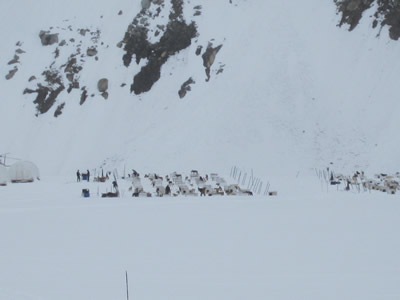

We thought we would just get to see and maybe pet a few dogs. But then came the big, delightful surprise. We actually got to "mush" not as long as the Iditarod, but an enjoyable few miles trip around the camp. In the picture below Nick and I are bonding with "our" dogs (I'm teh one in the blue hoodie) and then ....
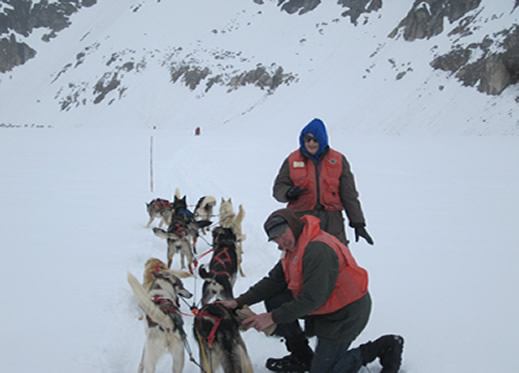
Here we are on the sled with me (blue hoodie) in the musher position The run began and I am proud to report that I did not cause the sled to overturn or do anything else stupid!
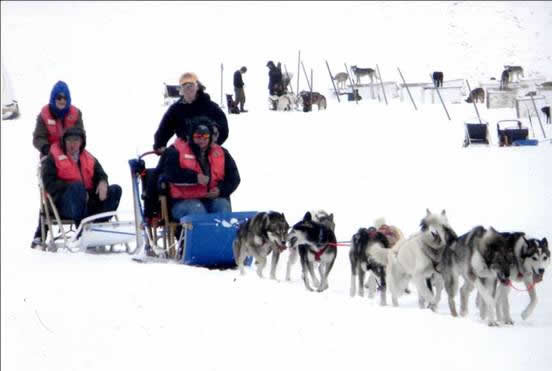
This was probably the greates experience of the trip. Not only because it was totally unexpected and fun, but because it reminded me of how we never really know how life will turn out. Many years ago in my long vanished youth I bought a record out of the bargain bin in a Hamburg, Germany department store. It was "North to Alaska". I liked the record, but could not understand all the words - particulary "mush". I tried long and hard to find out what that meant, but it took many years, after i had moved to teh US that i found out that this was the title song of an old John Wayne movie and "mush" was a term related to dogsledding. And there, in my old age I was allowed to be a "musher", even if only for a short time. You just never know what life will deal you.
After the chopper returned us to Skagway we embarked on the second part of our short stay in skagway - a ride on the famous White Pass and Yukon Railway. As I mentioned at the beginning, every stampeder not only had to hike the 550 miles to Dawson, but also had to lug or transport with mules or horses a ton of provisions up teh Chilookt or White pass before he could reach the Yukon goldfields. The historic pictures (and the video accompanying the song "North to Alaska" show a staging area and the "ants" crawling up the Chilkoot pass.
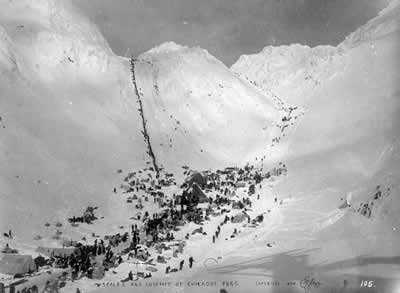

The railroad provided a much more pleasant way to reach the Yukon. It was constructed in less than two years and is recognized as a historical technical masterpiece, like the Eiffel tower. By the time the track was completed the actual goldrush had petered out, but the railroad continued to carry passengers, cargo and ore until it was phased out after the completion of a highway. Today the train serves primarily the tourist trade.
The pictures below show how the rocks across from the cruiseship quai are covered with cruiseship graffiti and the other picture shows the trainstation which was right across from our ship.


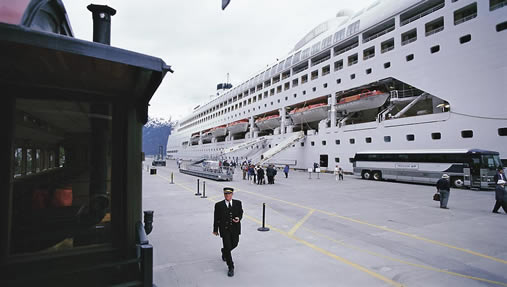
The train ride covers only a fraction of the distance to the goldfields, but it is long (and slow) enough to make it possible to appreciate the technical accomplishment represented by the track and the spectacular scenery. The train windes its way up and down the mountains, at several places one can see both the beginning and the train from one's seat.

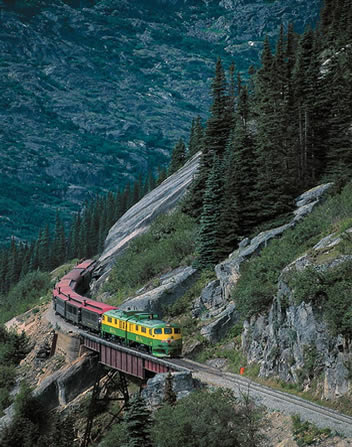
Below are pictures of the old trestle bridge which, thank God is not used anymore today. Even though thousands used this bridge without mishap. we were glad to see it from a distance, while we rode over a modern bridge.
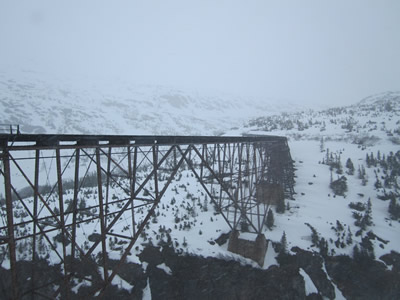

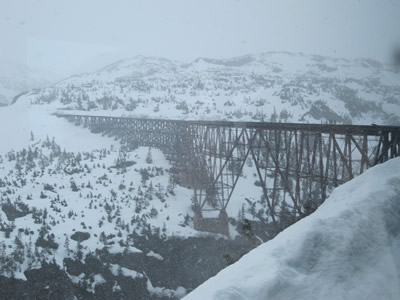
Water fall, fed by melting snow The Skagway creek


For more excellent pictures of the railroad click on this link of the White Pass Yukon Railway webseite
We had to return to our ship, next stop: Tracy Arms Fjord und Sawyer Gletscher